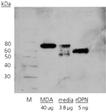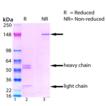Product Details
| Alternative Name: | OPN, SPP1, Secreted phosphoprotein 1, Bone sialoprotein 1 |
| |
| Clone: | 53 |
| |
| Host: | Mouse |
| |
| Isotype: | IgG2a |
| |
| Immunogen: | Recombinant human Osteopontin. |
| |
| UniProt ID: | P10451 |
| |
| Source: | Purified from ascites. |
| |
| Species reactivity: | Human
|
| |
| Applications: | ELISA, IHC (FS), IHC (PS), WB
|
| |
| Purity Detail: | Protein G affinity purified. |
| |
| Formulation: | Liquid. In PBS containing 0.1% sodium azide. |
| |
| Handling: | Avoid freeze/thaw cycles. |
| |
| Shipping: | Blue Ice |
| |
| Long Term Storage: | -20°C |
| |
| Scientific Background: | Osteopontin (OPN) is an acidic extracellular matrix cell adhesion protein that is relatively abundant not only in bone matrix, plasma, urine, and milk, but is also found in malignant and atherogenic tissues. Phosphorylation, glycosylation and calcium modifications allow intact and fragmented Osteopontin to direct a variety of diverse responses including tissue remodeling, inflammation and cell survival. Plasma Osteopontin has been shown to provide prognostic information in breast, prostate, colon, and lung cancers as well as metastatic carcinomas. The notable presence of Osteopontin in a variety of tumors is strongly correlated to pathological stage, suggesting its critical role in tumor invasiveness, progression and metastasis. In addition, Osteopontin inhibits inducible nitric oxide synthase activity, thereby protecting tumor cells from NO-mediated macrophage cytotoxic attack. Osteopontin is found in atherosclerotic plaques and may drive a number of diabetic vascular pathologies. |
| |
| Regulatory Status: | RUO - Research Use Only |
| |
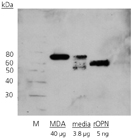
Western blot analysis: Protein samples (MDA-MB-435 cell lysates, conditioned medium from MDA-MB-435 cells containing secreted OPN or recombinant protein) were resolved by SDS-PAGE on a 8-16% gradient gel, transferred to nitrocellulose, and blocked for 2 hrs in Tris-buffered saline containing 0.05% Tween 20 (TBS-T) and 5% milk powder. For immunodetection, Blots were incubated with anti-OPN 53 (5µg/ml) overnight at 4°C, followed by incubation with a HRP-conjugated goat anti-mouse secondary antibody (in TBS-T) for 1 hr at room temperature. Protein bands were visualized by enhanced chemiluminescence on Kodak X-OMAT film. M= Magic Mark.
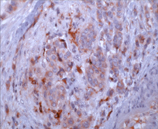
Immunohistochemistry analysis of formalin-fixed, paraffin-embedded breast cancer tissue stained with 2µg/ml anti-OPN 53.
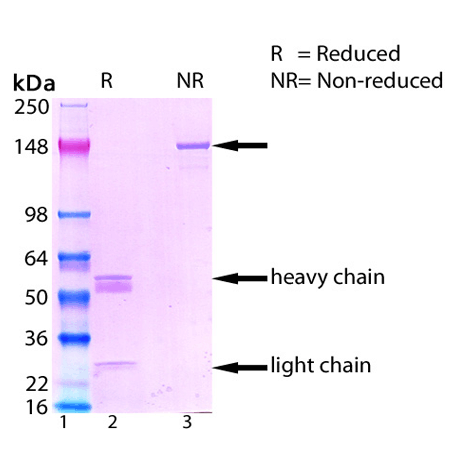
SDS-PAGE analysis of ADI-905-629: Lane 1: MW Marker, Lane 2 and Lane 3: 2µg of Osteopontin monoclonal antibody (53), resolved under reduced and non-reduced condition.
Please mouse over
Product Literature References
Intrauterine botulinum toxin A administration promotes endometrial regeneration mediated by IGFBP3-dependent OPN proteolytic cleavage in thin endometrium: D. Lee, et al.; Cell. Mol. Life Sci.
80, 26 (2023),
Abstract;
Phosphorylated Osteopontin Secreted from Cancer Cells Induces Cancer Cell Motility: Y. Kariya, et al.; Biomolecules
11, 1323 (2021),
Abstract;
Isoform-specific promotion of breast cancer tumorigenicity by TBX3 involves induction of angiogenesis: M. Krstic, et al.; Lab. Invest.
100, 400 (2020),
Abstract;
Full Text
Increased cerebrospinal fluid osteopontin levels and its involvement in macrophage infiltration in neuromyelitis optica: Y. Kariya, et al.; BBA Clin.
3, 126 (2015),
Application(s): Western Blotting, cell staining,
Abstract;
Full Text
Assessment of osteopontin in early breast cancer: correlative study in a randomised clinical trial: V.H. Bramwell, et al.; Breast Cancer Res.
16, R8 (2014),
Abstract;
Full Text
Expression and localization of osteopontin, homing cell adhesion molecule/CD44, and integrin αvβ3 in mucoepidermoid carcinoma and acinic cell adenocarcinoma of salivary gland origin: T.C. Fok, et al.; Oral Surg. Oral Med. Oral Pathol. Oral Radiol.
118, 320 (2014),
Abstract;
Osteopontin increases breast cancer cell sensitivity to specific signaling pathway inhibitors in preclinical models: J.C. Mutrie, et al.; Cancer Biol. Ther.
12, 680 (2011),
Abstract;
The therapeutic effects and optimal timing of granulocyte colony stimulating factor intrauterine administration during IVF-ET: J. Won, et al.; Life Sci.
317, 121444 ( 2023),
Abstract;
Related Products







